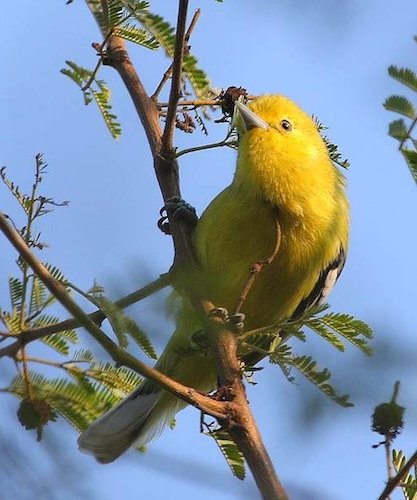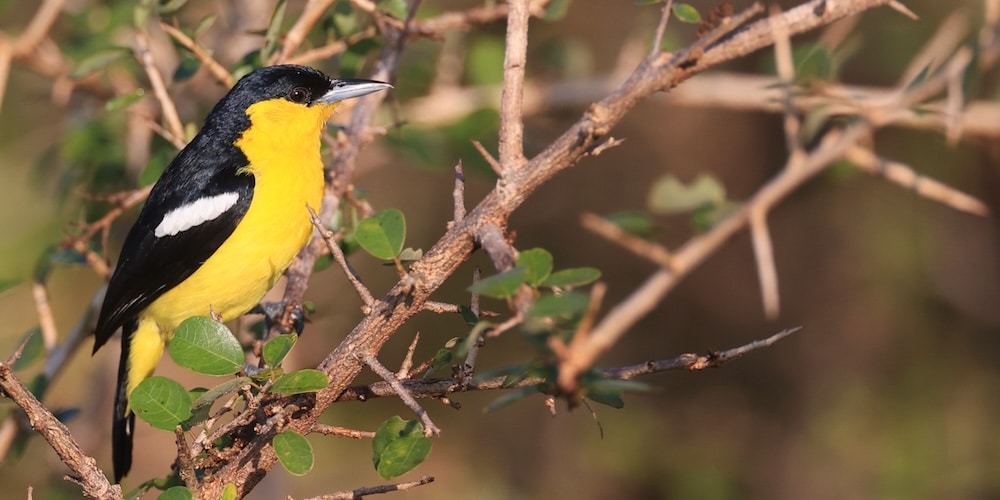Aegithinidae – Ioras

The Aegithinidae (Ioras) are a small family of four passerine species in the genus Aegithina found in the Indian sub-continent and southeast Asia. They are one of only three bird families that are entirely endemic to the Indo-Malayan ecozone. They were formerly grouped with the other two of those groups, the leafbirds and fairy-bluebirds, in the Irenidae family.
They are small to medium small sized passerines, ranging from 11.5 to 15. 5 cm in length. Overall the males are larger than the females. These are reminiscent of the bulbuls, but whereas that group tends to be drab in colouration, the ioras are more brightly coloured. The group exhibits sexual dimorphism in its plumage, with the males being brightly plumaged in yellows and greens. Unlike the leafbirds, ioras have thin legs, and their bills are proportionately longer. Calls are strident whistles; songs that are musical to human ears.
Their habitats include acacia scrub, forest edge, and closed forests, as well as agricultural land and (in the common iora) gardens. They are mostly lowland birds, with most reaching only as high as the submontane forests. They are generally highly arboreal and usually occur in the tree canopy, with only very rare records of this family coming down to the ground. They hop, bound, and flit through the canopy, often foraging out on branch tips and hanging upside-down. Ioras are insectivorous and eat insects and other small invertebrates like spiders, which they find by nimbly gleaning the leaves of the slenderest outer twigs.

Common Iora Aegithina tiphia – ©Nick Green Bird-Photo-Tours ASIA
The family is generally non-migratory, although in Western India there is some evidence that Marshall’s Ioras and Common Ioras are partial migrants in the seasonal semi-desert fringe.
In the two species whose male courtship displays are known, they are elaborate, culminating in the males’ parachute-style descent looking like green balls of fluff. Some have suggested that the demands of these flights have led to selection for the relatively short tails of adult males. The nests are compact open cups felted to branches with spiderweb. Females lay 2 or 3 eggs, which have pinkish speckles and red and purple lines. They incubate at night; the males, by day. Incubation lasts about 14 days. Both parents share responsibility for brooding and feeding.
Ioras will commonly live close to humans and even lives in the suburbs of cites like Singapore. They are mostly not threatened by human activities, although the green iora is listed as near threatened by the IUCN, habitat loss being responsible for its decline. Unlike many other passerines they are not common species in the cage bird trade.
-
Number of bird species: 4
(As at November 2025)
According to the recently (2025) amalgamated AviList, there are just four species of Ioras, in one genus in the Aegithinidae family. They are:
Common Iora Aegithina tiphia
Marshall’s Iora Aegithina nigrolutea
Green Iora Aegithina viridissima
Great Iora Aegithina lafresnayei
-
Aegithinidae
Family AccountThe ioras are common insectivorous birds of Asian forests and gardens. -
Aegithinidae
Family AccountThe ioras are a small family, Aegithinidae, of four passerine bird species found in south and southeast Asia.
Given that this is a very small family with just four species of Iora in just one genus, Fatbirder provides active links below to all species.
-
Common Iora Aegithina tiphia
Species AccountThe common iora (Aegithina tiphia) is a small passerine bird found across the tropical Indian subcontinent with populations showing plumage variations, some of which are designated as subspecies. -
Common Iora Aegithina tiphia
Species AccountSound archive and distribution map -
Great Iora Aegithina lafresnayei
Species AccountThe great iora (Aegithina lafresnayei) is a species of bird in the Aegithinidae family. It is found in Cambodia, China, Laos, Malaysia, Myanmar, Thailand, and Vietnam. Its natural habitat is subtropical or tropical moist lowland forests. -
Great Iora Aegithina lafresnayei
Species AccountSound archive and distribution map -
Green Iora Aegithina viridissima
Species AccountThe green iora (Aegithina viridissima) is a species of bird in the Aegithinidae family. It is found in Brunei, Indonesia, Malaysia, Myanmar, Singapore, and Thailand. -
Green Iora Aegithina viridissima
Species AccountSound archive and distribution map -
Marshall's Iora Aegithina nigrolutea
Species AccountThe white-tailed iora or Marshall's iora (Aegithina nigrolutea),[2] is a songbird in the genus Aegithina found in parts of India and Sri Lanka. -
Marshall's Iora Aegithina nigrolutea
Species AccountSound archive and distribution map
